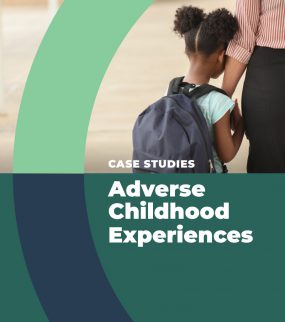Adverse Childhood Experiences
How can programs to prevent adverse childhood experiences work to reduce drug overdose?
Adverse childhood experiences (ACEs) are preventable, potentially traumatic events that occur in childhood (0-17 years), such as neglect, experiencing or witnessing violence, and having a family member attempt or die by suicide. ACEs also include aspects of a child’s environment that can undermine their sense of safety, stability, and bonding, such as growing up in a household with:
- Mental health problems
- Instability due to parental separation
- Incarceration of a parent, sibling, or other member of the household
- Substance use1,2
Behavioral Risk Factor Surveillance System data collected from 25 states from 2015-2017 showed that 61% of adults reported experiencing some form of ACEs during their childhood, and approximately 1 in 6 reported experiencing four or more ACEs.3 Studies show that a higher number of these experiences are associated with poor mental and physical health outcomes, chronic medical conditions, employment difficulties, and lower educational attainment in adulthood.3,4
A growing body of work within the field of ACEs focuses on its intersection with substance use disorders (SUDs). ACEs are positively correlated with substance use and SUD risk in adulthood.5,6 A recent scoping review indicated that those in treatment for SUDs had a higher prevalence of ACEs than those in the general population and found an association between ACEs and the development of SUDs.7 ACEs and SUDs have also been seen to have an intergenerational effect — exposure to parental substance use is an ACE that is associated with increased risk for substance use.1,8 In recognizing the lasting negative effects ACEs can have, CDC collated a set of six evidence-based ACEs prevention and response strategies [PDF]:1
- Strengthen economic support to families
- Promote social norms that protect against violence and adversity
- Ensure a strong start for children
- Teach skills to handle stress, resolve conflicts, and manage emotions and behaviors
- Connect youth to caring adults and activities
- Intervene to lessen immediate and long-term harms
Case Study Snapshots
- The Injury-Free Louisiana Shared Risk and Protective Factors Academy (IFLA)a trains community partners on public health approaches, the importance and focus of primary prevention, and how to implement strategies. They use a shared risk and protective factor (SRPF) approach to prevent multiple forms of violence and injury that emphasizes the link between ACEs and SUDs.
- IFLA trainings consist of two 2-day sessions and one 1-day session.
- Only one region in Louisiana is selected for each academy session. Regions are chosen for IFLA participation based on the burden (i.e., number or rate) of injuries in the community and the number and strength of partner and/or community level relationships to ensure interest and initiative for the trainings.
- Once a region is chosen, IFLA solicits applications and convenes a multidisciplinary team of five to seven individuals in multiple sectors, including behavioral health, public health, education, law enforcement, social services, and housing. Selected teams design and implement interventions that decrease and prevent injury and violence, including overdose.
- Trainers, also called coaches, are public health professionals who have been through the academy training with an IFLA trainer. Trainers are integral to the success of the academy.
- To date, two academies have been held, with 21 individuals in the 2019 academy and 13 individuals in the 2020 academy (7 teams total).
- The Strengthening Families Program (SFP)a is a nationally and internationally recognized evidence-based program that focuses on individual coaching and has a two-generation strategy: children ages 6–11 and their parents and/or caregivers work on parallel activities, separately and together. These activities are designed to improve family relationships and to break generational cycles of violence, neglect, and substance use.
- SFP has been implemented in South Carolina for the past seven years through various funding streams and a nonprofit organization, Children’s Trust, the largest provider of SFP in South Carolina.
- SFP includes structured components (parent skills training, children’s skills training, and family relationship skills training) and limits group sizes to seven to nine families from each county. A standard booster session is held up to 90 days after the program’s completion, and a session is held annually to bring families from previous cycles back together.
- Trainers complete an initial SFP group leader training and then become eligible to implement a cycle of SFP. Annual trainings and virtual meetings with peer trainers are also held to share best practices and lessons learned.
- Children’s Trust works with the South Carolina Department of Alcohol and Other Drug Abuse Services (DAODAS) partners to recruit families for SFP. Family referrals are also obtained through the child welfare department, faith-based communities, schools, the housing authority, community-based organizations, and past graduates of the program.
- Site selection for SFP implementation was based on South Carolina’s vulnerability assessment used to identify areas with high opioid overdose burden and low resources.
For more information about Injury-Free Louisiana Shared Risk and Protective Factors Academy & South Carolina’s Strengthening Families Program, check out the full case study here [PDF – 18 pages].


